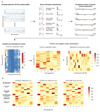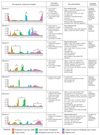Copy number signatures and mutational processes in ovarian carcinoma
- PMID: 30104763
- PMCID: PMC6130818
- DOI: 10.1038/s41588-018-0179-8
Copy number signatures and mutational processes in ovarian carcinoma
Abstract
The genomic complexity of profound copy number aberrations has prevented effective molecular stratification of ovarian cancers. Here, to decode this complexity, we derived copy number signatures from shallow whole-genome sequencing of 117 high-grade serous ovarian cancer (HGSOC) cases, which were validated on 527 independent cases. We show that HGSOC comprises a continuum of genomes shaped by multiple mutational processes that result in known patterns of genomic aberration. Copy number signature exposures at diagnosis predict both overall survival and the probability of platinum-resistant relapse. Measurement of signature exposures provides a rational framework to choose combination treatments that target multiple mutational processes.
Conflict of interest statement
Competing Financial Interests Statement
The following authors the authors have a competing interest as defined by Nature Research:
C.G. Personal interest: Roche, AstraZeneca, Tesaro, Clovis, Foundation One, Nucana. Research funding: AstraZeneca, Novartis, Aprea, Nucana, Tesaro. Named co-inventor on five patents (issued: PCT/US2012/040805; pending: PCT/GB2013/053202, 1409479.1, 1409476.7 and 1409478.3)
H.G. Employment: AstraZeneca
I.McN. Personal interest: Clovis Oncology.
J.D.B. Cofounder and shareholder of Inivata Ltd (a cancer genomics company that commercializes ctDNA analysis)
All other authors declare that they have no competing financial or non-financial interests as defined by Nature Research.
Figures





Comment in
-
Copy number signatures in ovarian cancer.Nat Genet. 2018 Sep;50(9):1208-1209. doi: 10.1038/s41588-018-0212-y. Nat Genet. 2018. PMID: 30158680 No abstract available.
References
-
- Fong PC, et al. Poly(ADP)-Ribose Polymerase Inhibition: Frequent Durable Responses in BRCA Carrier Ovarian Cancer Correlating With Platinum-Free Interval. J Clin Oncol. 2010;28:2512–2519. - PubMed
Publication types
MeSH terms
Grants and funding
LinkOut - more resources
Full Text Sources
Other Literature Sources
Medical

